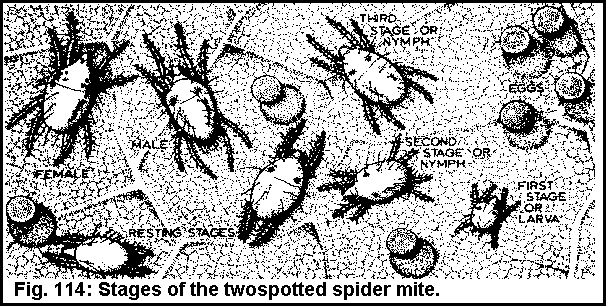|
These pests are small 8 legged insects
closely related to spiders. They are far more active in
warmer climates and this is the reason why inside they
mostly occur during spring and autumn. They seek refuge
inside from the cold nights outside so they can
effectively start their breeding cycle.
The type
you are most likely to encounter will show damage by
sucking sap from the leaves.
Although mites
differ from insects in several ways, their damage to
ornamental plants resembles that of thrips and lace
bugs. Most mites have eight legs as adults (adult
insects usually have six). Mites do not have wings (some
adult insects have wings) but can be aerially dispersed
by breezes and winds more or less like aerial plankton,
particularly in hot, dry weather. It is thought the
mouthparts (chelae) of mites evolved from legs with a
prehensile joint, (the digitus mobilus) which allows the
mite to chew with a vertical, scissors like action. In
spider mites, broad mites, and cyclamen mites, the
chelae have evolved into sharp mouthparts that mites use
to pierce the surface of the plants they feed on in
order to suck out the contents of the plant cells. Mites
evidently inject saliva as they feed for one of the
first symptoms of broad mite and cyclamen mite feeding
is failure of the host plant to blossom. Infested plants
then exhibit a variety of plant growth regulator
symptoms including twisted and distorted growth, and
shortened internodes and petioles.
Adult-
The eight-legged adult can be pale green, greenish
amber, or yellowish. Usually having two (sometimes four)
black spots on top, the twospotted spider mite is about
0.4 mm long.
Egg-
The spherical egg ranges
from transparent and colorless to opaque straw yellow.
Larva-
The six-legged larva is colorless,
pale green, or yellow.
Nymph-
Similar to the
adult except in size, the nymph has eight legs and is
pale green to brownish green. Large black spots may
develop on each side.

|